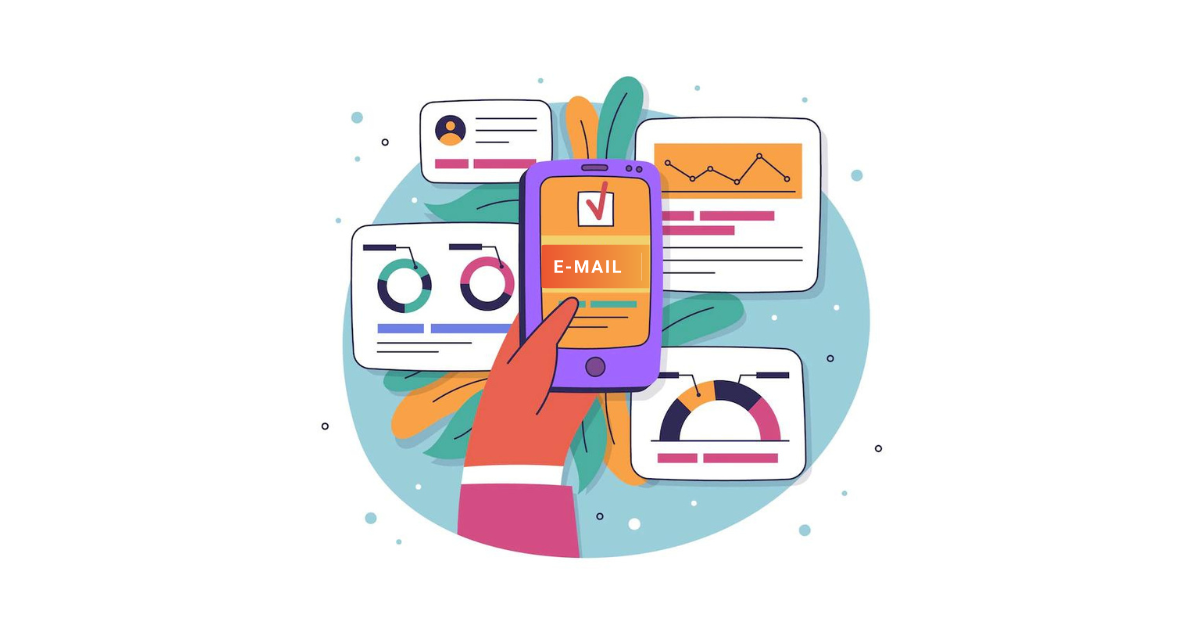In fact, Email Marketing continues to be one of the essential communication channels for brands rather than “dying” as people think. The power of email is undeniable, but the challenge is to compete with other emails.
Effective email marketing campaigns go through four main stages:
- Brainstorming and planning phase
- Design and create email layouts, content, CTAs, etc.
- Schedule and launch campaigns
- Monitor and analyze key metrics
While this is an email campaign roadmap, what is often not discussed is including email campaign management practices in a marketing strategy. Campaign management practices run parallel to creating and launching email campaigns.
What is Email Marketing Campaign Management?
Email campaign management, by definition, deals with the interconnected process of conceiving, creating, launching, and monitoring an email campaign. There are many steps involved in this process, and email campaign management methods help streamline this process.

The Challenges of Email Campaign Management
You can’t do without an email campaign management practice in place, but you can’t do it without addressing two core challenges.
Challenge 1: Streamline the entire process from start to finish
An email marketing campaign is not limited to one task. There are many parts to it. A common challenge that most marketers face is getting every part of the campaign up and running on time. Design, content, layout, testing, planning, and monitoring must be streamlined.
If there is a delay in any step, the email campaign will stop. In campaign management, a major challenge is to have everything marked and completed on time.
Challenge 2: Handling Email Marketing Assets
Assets are the building blocks of your emails. Sometimes you have to go beyond your marketing team to get the assets or information you need for your email campaign. The whole coordination between different teams can be super fast or slow while waiting for each other.
This is in sync with streamlining but remains a recurring challenge in email campaign management.
Email Campaign Management Practices to Get Started
Effective campaign management includes the following stages:
- Create clean email lists with proper segmentation and tags
- Design and edit email templates
- Set up automated drip sequences using your business email address to avoid spam filters
- Personalize email content with dynamic and interactive content
- A/B test emails and optimize to get desired results
- Schedule campaigns at specific times for better engagement, especially if targeting a global audience
- Track, report and analyze key engagement and conversion metrics
- Implement integrations with your CRM or any essential platform to streamline management.
Whether sending one-off emails or automated drips, these email campaign management methods are essential for tying all your efforts into one place and tracking overall email performance.
Define clear campaign goals
Having a clear goal can help manage the execution and monitoring of your email campaign.
Before you start designing your campaign, ask questions like:
- What do I want to achieve with this campaign?
- What metrics do I want to measure?
Once you know what results you want to drive through your email campaigns, you can align them with your overall marketing, sales, and business goals.
Defining your goals helps:
- Create email content that aligns with your goals
- Define drip sequences to drive lead engagement in the right direction
- Make quick decisions throughout the process
- Optimize campaigns through A/B testing
- Target the right audience at the right time.
Here is an example of how a clearly defined goal is key in the campaign management process.
Objective: Your email campaign objective – to update your Pro subscribers about a new feature addition that was originally part of the higher-paid plans. Pro subscribers can access this feature for free, while free users can try it out for 7 days.
Campaign Management Process: Now that you have a clearly defined goal, your next steps include:
- Segment your subscribers to fit the bill
- Create dynamic content to display relevant messages to subscribers across all stages
- Plan your drip sequence based on user engagement
- Make sure CTAs, UI, language, etc. align with your brand voice
- Test your campaigns until you see the engagement metrics you want.
- Schedule based on subscriber demographics and engagement
- Track and optimize your drip sequences for better results
A clearly defined goal helps streamline and manage the entire process, from start to finish.
Deploy Email Marketing tools
Email marketing tools are designed to make email campaigns run smoothly. Email marketing tools have everything from ready-to-use email templates to troubleshooting server issues.
Using a professional tool can help you manage your email campaigns efficiently as it centralizes the entire process in one place. This makes it easier to manage and monitor with all the dashboards and reports in one place. Plus, you can get your teams working together on your email campaigns in a cohesive manner.
However, there are many tools available and choosing one can seem daunting. The easiest way to decide is to choose a tool that serves your end goal and fits your business needs. In general, here are a few things your email marketing tool should have:
- Security: Email communications are more than just sending brand information or updates. Email addresses are personal and sensitive customer data. Choose an email marketing tool with data protection best practices, such as email authentication standards.
- Segmentation: This is a no-brainer. Your email marketing tool should have this feature along with user tagging. Many tools offer features like adding notes to internal groups versus user profiles for better email engagement.
- Ease of Use: You need a tool that will save you time. If your tool is complicated to use, then you need to reconsider. It should be a smooth ride from ready-to-use templates to creating dynamic content and adding media.
- Email Automation: Again, this is a no-brainer and essential. Choose a tool that has ready-to-implement automated workflows, triggered sends, A/B testing, and global email scheduling options.
- Third-party integrations: Make sure your email marketing tool integrates with your CRM and task management tools. Otherwise, the whole process will have many downtimes while you juggle between multiple tools.
Build a Comprehensive Content Calendar
Using a content calendar for your email campaigns is a great place to start organizing and managing your campaigns. Email marketing is all about delivering the right message at the right time to the right audience. You can do all of this in one go with a pre-planned content calendar that’s ready to follow.
To stay on track and manage, start by carefully mapping out your email campaigns. Plan what messages you want to send, how you want to create them, and what you need to do to make sure everything runs smoothly.
Your content calendar will help you map out your campaign ideas, timeline, design ideas, tone of voice, CTAs, landing pages, meme ideas, metrics to track, team members leading each part of the campaign, and more.
You can create a calendar manually using Google Sheets or choose any ready-to-use email content calendar tool. A content calendar for email campaign management helps:
- Campaign Goal Mapping
- Map one-time campaigns to specific events or specific occasions
- Assign team members to each task
- Drip Sequence Planning
- Target audience mapping
- Decide when the campaign starts and when it continues or after how many minutes, hours or days the drip sequence starts
- Measure key KPIs and review overall performance metrics
Segment and personalize your email campaigns
The impact and need for segmentation and personalized messaging has been discussed since the beginning of this article.
These two things act as the backbone of any email campaign. When you want to implement best practices for managing your email campaigns, focusing on precise segmentation and delivering personalized messages can do wonders for you.
Proper segmentation and tagging make for effective communication. When you create segments with audiences that share common behaviors and interests, it becomes easier to deliver more relevant messages to each subscriber.
Each segment will have a specific shared interest, which will determine the type of content and design you need for your email campaigns. At the same time, effective segmentation also paves the way for redefining the metrics you want to measure. These can be different for each segment.
Delivering personalized and targeted messages to your subscribers increases the chances of email opens, email clicks, and conversions and also demonstrates an overall customer experience.
Another less-addressed impact of segmentation and personalization is on subject lines. Since each segment will have a different interest or behavioral pattern, each campaign’s subject line will be different.
This is important because the subject line is the first thing your subscribers see. Create personalized subject lines that have the highest chance of being clicked.
“When we noticed some of our players drifting away, we segmented our users based on their engagement levels and sent personalized email campaigns,” said Holger Sindbaek, founder of Online Solitaire. “Active players received enhanced strategies and previews of upcoming features. We welcomed inactive players back into the game by highlighting games that were easy, relaxing, and fun. This approach revived interest, bringing back 26% of our inactive players. It showed us that understanding and connecting with each player’s unique preferences isn’t just a good strategy; it’s a way to weave a stronger, more connected community.”
Data Monitoring and Analysis
Knowing what to analyze and how much is essential to managing an email campaign. Your starting point should be identifying the KPIs you want to track and optimize for. Unless you identify the key metrics you want to track, you won’t be able to measure the success or failure of your campaign.
Map out your analytics and decide what each metric will tell you about your campaign. For example, click-through rate and form submissions can help you understand how well your campaign is performing.
Some important metrics that define any email campaign are:
- Email open rate
- Click through
- Conversion rate
- Bounce Rate
- Unsubscribe Rate
These 5 metrics help you understand whether your campaigns are effectively engaging your audience. When choosing your email marketing tool, make sure it has reporting and analytics features so everything is automatically tracked and analyzed for you.
Also, align your metrics with the goals of your campaign. If you send an onboarding campaign, the goal is to educate your new users. The metrics for this campaign will be different than metrics sent to generate leads for your upcoming webinar.

End
Email campaign management strategies go hand in hand with email campaign marketing plans. It is not a separate part but an integral part of defining your campaign and enabling your team to do the same.
All campaign management strategies boil down to one simple rule – team coordination. Without this, it’s difficult to put all the pieces together at once and focus on high-value actions. With the right tools and proper coordination, campaign management doesn’t have to seem daunting.
Source: 5 Actionable Email Campaign Management Tips You Need to Know
Comment Policy: We truly value your comments and appreciate the time you take to share your thoughts and feedback with us.
Note: Comments that are identified as spam or purely promotional will be removed.
To enhance your commenting experience, consider creating a Gravatar account. By adding an avatar and using the same e-mail here, your comments will feature a unique and recognizable avatar, making it easier for other members to identify you.
Please use a valid e-mail address so you can receive notifications when your comments receive replies.
